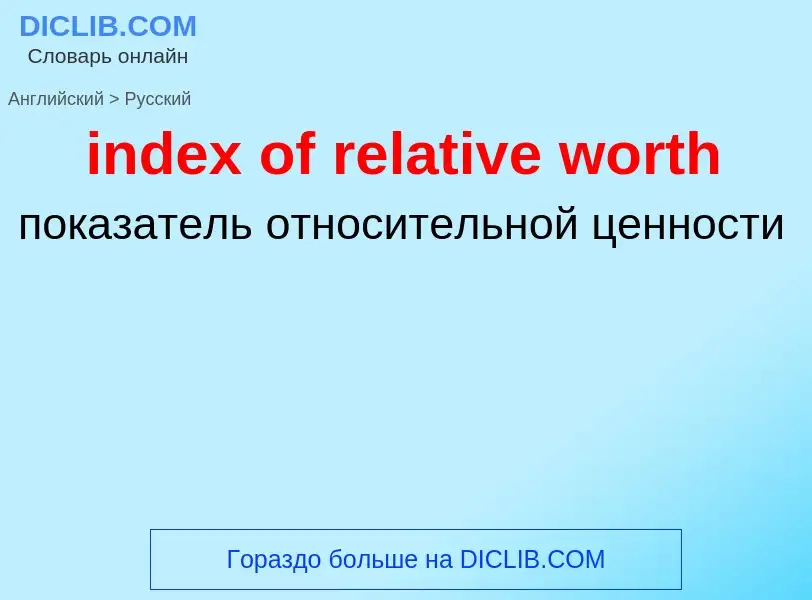Translation and analysis of words by ChatGPT artificial intelligence
On this page you can get a detailed analysis of a word or phrase, produced by the best artificial intelligence technology to date:
- how the word is used
- frequency of use
- it is used more often in oral or written speech
- word translation options
- usage examples (several phrases with translation)
- etymology
index of relative worth - translation to russian
['fɔ:t'wə:θ]
география
г. Форт-Уорт
общая лексика
показатель преломления
оптика
коэффициент преломления
Definition
Wikipedia
The relative strength index (RSI) is a technical indicator used in the analysis of financial markets. It is intended to chart the current and historical strength or weakness of a stock or market based on the closing prices of a recent trading period. The indicator should not be confused with relative strength.
The RSI is classified as a momentum oscillator, measuring the velocity and magnitude of price movements. Momentum is the rate of the rise or fall in price. The relative strength RS is given as the ratio of higher closes to lower closes. Concretely, one computes two averages of absolute values of closing price changes, i.e. two sums involving the sizes of candles in a candle chart. The RSI computes momentum as the ratio of higher closes to overall closes: stocks which have had more or stronger positive changes have a higher RSI than stocks which have had more or stronger negative changes.
The RSI is most typically used on a 14-day timeframe, measured on a scale from 0 to 100, with high and low levels marked at 70 and 30, respectively. Short or longer timeframes are used for alternately shorter or longer outlooks. High and low levels—80 and 20, or 90 and 10—occur less frequently but indicate stronger momentum.
The relative strength index was developed by J. Welles Wilder and published in a 1978 book, New Concepts in Technical Trading Systems, and in Commodities magazine (now Modern Trader magazine) in the June 1978 issue. It has become one of the most popular oscillator indices.
The RSI provides signals that tell investors to buy when the security or currency is oversold and to sell when it is overbought.
RSI with recommended parameters and its day-to-day optimization was tested and compared with other strategies in Marek and Šedivá (2017). The testing was randomised in time and companies (e.g., Apple, Exxon Mobil, IBM, Microsoft) and showed that RSI can still produce good results; however, in longer time it is usually overcome by the simple buy-and-hold strategy.



![Boise State]] against TCU Boise State]] against TCU](https://commons.wikimedia.org/wiki/Special:FilePath/Boise State 2010 Fiesta Bowl.jpg?width=200)
 (14770397571).jpg?width=200)

.jpg?width=200)

![Fort Worth Museum of Science and History is adjacent to the [[National Cowgirl Museum and Hall of Fame]]. Fort Worth Museum of Science and History is adjacent to the [[National Cowgirl Museum and Hall of Fame]].](https://commons.wikimedia.org/wiki/Special:FilePath/Fort Worth Cultural District June 2016 05 (Fort Worth Museum of Science and History).jpg?width=200)
.jpg?width=200)
.jpg?width=200)

![Kennedy]] in Fort Worth on Friday morning, November 22, 1963: He was assassinated in Dallas later in the day. Kennedy]] in Fort Worth on Friday morning, November 22, 1963: He was assassinated in Dallas later in the day.](https://commons.wikimedia.org/wiki/Special:FilePath/Fort Worth rally, 22 November 1963.jpg?width=200)




 c 1907.png?width=200)


.jpg?width=200)
![[[Phyllis J. Tilley Memorial Bridge]] [[Phyllis J. Tilley Memorial Bridge]]](https://commons.wikimedia.org/wiki/Special:FilePath/Phyllis J. Tilley Memorial Bridge, Fort Worth, Texas.jpg?width=200)
![U.S. Post Office]] in Fort Worth U.S. Post Office]] in Fort Worth](https://commons.wikimedia.org/wiki/Special:FilePath/PostOffice1.jpg?width=200)
.png?width=200)



.jpg?width=200)





![[[Diamond]]s have a very high refractive index of 2.417. [[Diamond]]s have a very high refractive index of 2.417.](https://commons.wikimedia.org/wiki/Special:FilePath/Brillanten.jpg?width=200)
![A [[calcite]] crystal laid upon a paper with some letters showing [[double refraction]] A [[calcite]] crystal laid upon a paper with some letters showing [[double refraction]]](https://commons.wikimedia.org/wiki/Special:FilePath/Calcite.jpg?width=200)

![power]] of a [[magnifying glass]] is determined by the shape and refractive index of the lens. power]] of a [[magnifying glass]] is determined by the shape and refractive index of the lens.](https://commons.wikimedia.org/wiki/Special:FilePath/Lupa.na.encyklopedii.jpg?width=200)
![Birefringent materials can give rise to colors when placed between crossed polarizers. This is the basis for [[photoelasticity]]. Birefringent materials can give rise to colors when placed between crossed polarizers. This is the basis for [[photoelasticity]].](https://commons.wikimedia.org/wiki/Special:FilePath/Plastic Protractor Polarized 05375.jpg?width=200)



![The colors of a [[soap bubble]] are determined by the [[optical path length]] through the thin soap film in a phenomenon called [[thin-film interference]]. The colors of a [[soap bubble]] are determined by the [[optical path length]] through the thin soap film in a phenomenon called [[thin-film interference]].](https://commons.wikimedia.org/wiki/Special:FilePath/Soap bubble sky.jpg?width=200)
![A [[split-ring resonator]] array arranged to produce a negative index of refraction for [[microwaves]] A [[split-ring resonator]] array arranged to produce a negative index of refraction for [[microwaves]]](https://commons.wikimedia.org/wiki/Special:FilePath/Split-ring resonator array 10K sq nm.jpg?width=200)
![In [[optical mineralogy]], [[thin section]]s are used to study rocks. The method is based on the distinct refractive indices of different [[mineral]]s. In [[optical mineralogy]], [[thin section]]s are used to study rocks. The method is based on the distinct refractive indices of different [[mineral]]s.](https://commons.wikimedia.org/wiki/Special:FilePath/Thin section scan crossed polarizers Siilinjärvi R636-105.90.jpg?width=200)
![Thomas Young]] coined the term ''index of refraction''. Thomas Young]] coined the term ''index of refraction''.](https://commons.wikimedia.org/wiki/Special:FilePath/Thomas Young (scientist).jpg?width=200)
![[[Total internal reflection]] can be seen at the air-water boundary. [[Total internal reflection]] can be seen at the air-water boundary.](https://commons.wikimedia.org/wiki/Special:FilePath/Total internal reflection of Chelonia mydas.jpg?width=200)
![Light of different colors has slightly different refractive indices in water and therefore shows up at different positions in the [[rainbow]]. Light of different colors has slightly different refractive indices in water and therefore shows up at different positions in the [[rainbow]].](https://commons.wikimedia.org/wiki/Special:FilePath/WhereRainbowRises.jpg?width=200)
